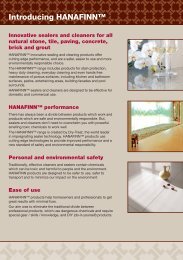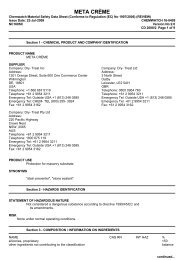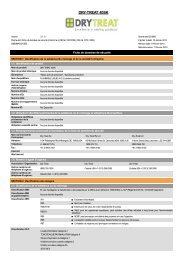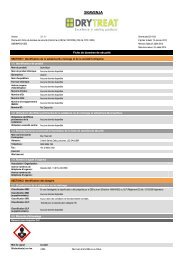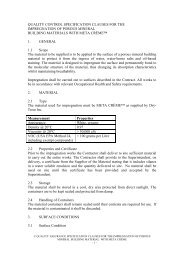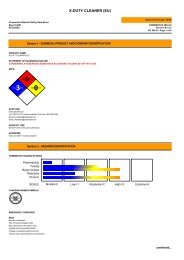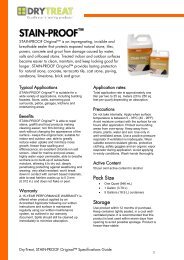Oxy-Klenza MSDS (UK) - Dry Treat
Oxy-Klenza MSDS (UK) - Dry Treat
Oxy-Klenza MSDS (UK) - Dry Treat
Create successful ePaper yourself
Turn your PDF publications into a flip-book with our unique Google optimized e-Paper software.
OXY-KLENZA<br />
Version 2.1.1.1 Chemwatch24-1001<br />
Chemwatch Material Safety Data Sheet (Conforms to Reg. (EC) No 1907/2006, Reg. (EC) No 1272/2008 and their amendments) Print Date: 14-Jan-2013<br />
CHEMWATCH SDS Revision Date:26-Jul-2010<br />
Issue Date: 26-Jul-2010<br />
SAFETY DATA SHEET<br />
SECTION 1: Identification of the substance / mixture and of the company / undertaking<br />
1.1. Product Identifier<br />
Product name: OXY-KLENZA<br />
Chemical product name: No data available<br />
Synonyms: cleaner<br />
Proper shipping name: No data available<br />
Chemical formula: No data available<br />
Other means of<br />
identification:<br />
No data available<br />
Index number: No data available<br />
ID number: No data available<br />
CAS number: No data available<br />
REACH registration number: No data available<br />
EC number: Not Available<br />
1.2. Relevant identified uses of the substance or mixture and uses advised against<br />
Relevant identified uses: Stone, tile and paver cleaner.<br />
Uses advised against: No data available<br />
1.3. Details of the supplier of the safety data sheet<br />
Registered company name: <strong>Dry</strong>-<strong>Treat</strong> Inc. <strong>Dry</strong>-<strong>Treat</strong> Pty Ltd <strong>Dry</strong>-<strong>Treat</strong> Ltd<br />
Address: 1104 Philadelphia Pike,Willmington,DE, 19809,USA 65 Nicholson Street,St. Leonards,NSW, 2065,AUS 3 North Street,Oatby,Leicester, LE2 5AH,GBR<br />
Telephone: +1 866 667 5119 1800 675 119 0800 0964 760<br />
Fax: +61 2 9954 3162 +61 2 9954 3162 +61 2 9954 3162<br />
Email:<br />
Website:<br />
1.4. Emergency telephone number<br />
Association / Organisation: <strong>Dry</strong>-<strong>Treat</strong> <strong>Dry</strong>-<strong>Treat</strong> <strong>Dry</strong>-<strong>Treat</strong><br />
Other emergency telephone<br />
numbers:<br />
(800) 255 3924 Outside USA +1 (813) 248 0585 Outside USA +1 (813) 248 0585<br />
Other emergency telephone<br />
numbers:<br />
Outside USA +1 (813) 248 0585<br />
SECTION 2: Hazards identification<br />
2.1. Classification of the substance or mixture<br />
DSD classification: In case of mixtures, classification has been prepared by following DPD (Directive 1999/45/EC) or CLP (Regulation (EC) No 1272/2008) regulations<br />
DSD classification<br />
(additional):<br />
No data available<br />
DPD classification: R22 Harmful if swallowed.<br />
R38 Irritating to skin.<br />
R41 Risk of serious damage to eyes.<br />
R66 Repeated exposure may cause skin dryness and cracking.<br />
CLP classification:<br />
CLP classification<br />
(additional):<br />
2.2. Label elements<br />
CLP label elements<br />
Acute Toxicity (Oral) Category 4<br />
Skin Corrosion/Irritation Category 2<br />
STOT - SE (Resp. Irr.) Category 3<br />
Serious Eye Damage Category 1<br />
No data available
Signal word: DANGER<br />
Hazard statement(s): H302 Harmful if swallowed.<br />
H315 Causes skin irritation.<br />
H335 May cause respiratory irritation.<br />
H318 Causes serious eye damage.<br />
Determined by Chemwatch using CLP criteria<br />
Additional Statement(s): No data available<br />
Supplementary<br />
statement(s):<br />
Code Phrase<br />
EUH066 Repeated exposure may cause skin dryness or cracking.<br />
Precautionary statement(s): Prevention<br />
Code Phrase<br />
P261 Avoid breathing dust/fume/gas/mist/vapours/spray.<br />
P264 Wash ... thoroughly after handling.<br />
P270 Do not eat, drink or smoke when using this product.<br />
P271 Use only outdoors or in a well-ventilated area.<br />
P280 Wear protective gloves/protective clothing/eye protection/face protection.<br />
DSD / DPD label elements<br />
Xn<br />
Relevant risk statements are found in section 2.1<br />
Response<br />
Code Phrase<br />
P301+P312 IF SWALLOWED: Call a POISON CENTER or doctor/physician if you feel unwell.<br />
P302+P352 IF ON SKIN: Wash with plenty of soap and water.<br />
P304+P340 IF INHALED: Remove victim to fresh air and keep at rest in a position comfortable for breathing.<br />
P305+P351+P338<br />
IF IN EYES: Rinse cautiously with water for several minutes. Remove contact lenses, if present and easy to do.<br />
Continue rinsing.<br />
P310 Immediately call a POISON CENTER or doctor/physician.<br />
P312 Call a POISON CENTER or doctor/physician if you feel unwell.<br />
P330 Rinse mouth.<br />
P332+P313 If skin irritation occurs: Get medical advice/attention.<br />
P362 Take off contaminated clothing and wash before re-use.<br />
Storage<br />
Code Phrase<br />
P403+P233 Store in a well-ventilated place. Keep container tightly closed.<br />
P405 Store locked up.<br />
Disposal<br />
Code Phrase<br />
P501 Dispose of contents/container to ...<br />
Indication(s) of danger: CONSIDERED A DANGEROUS MIXTURE ACCORDING TO DIRECTIVE 1999/45/EC AND ITS AMENDMENTS.<br />
Safety advice: S22 Do not breathe dust.<br />
S24 Avoid contact with skin.<br />
S25 Avoid contact with eyes.<br />
S36 Wear suitable protective clothing.<br />
S37 Wear suitable gloves.<br />
S39 Wear eye/face protection.<br />
S51 Use only in well ventilated areas.<br />
S09 Keep container in a well ventilated place.<br />
S40 To clean the floor and all objects contaminated by this material, use water.<br />
S13 Keep away from food, drink and animal feeding stuffs.<br />
S26 In case of contact with eyes, rinse with plenty of water and contact Doctor or Poisons Information Centre.<br />
S46 If swallowed, IMMEDIATELY contact Doctor or Poisons Information Centre. (show this container or label).<br />
2.3. Other hazards
PBT/vPvB criteria No data available<br />
R20? Inhalation may produce health damage*.<br />
R33? Cumulative effects may result following exposure*.<br />
R37? May produce discomfort of the respiratory system*.<br />
SECTION 3: Composition / information on ingredients<br />
3.1. Substances<br />
See 'Composition on ingredients' in section 3.2<br />
3.2. Mixtures<br />
1. CAS No<br />
2. EC No<br />
3. Index No<br />
4. REACH No<br />
1. 4452-58-8<br />
2. 239-707-6<br />
3. No data available<br />
4. No data available<br />
1. 1344-09-8<br />
2. 215-687-4<br />
3. No data available<br />
4. No data available<br />
1.<br />
2. No data available<br />
3. No data available<br />
4.<br />
%[weight] Name<br />
30-60 sodium percarbonate<br />
1-10 sodium metasilicate<br />
balance<br />
SECTION 4: First aid measures<br />
4.1. Description of first aid measures<br />
ingredients determined not to be<br />
hazardous<br />
Classification according to Directive<br />
1999/45/EC [DPD]<br />
O R8<br />
Xn R22<br />
R38<br />
R41<br />
R66<br />
R20?<br />
R33?<br />
R37?<br />
C R34<br />
R22<br />
R41<br />
R33?<br />
Classification according to (EC) No 1272/2008<br />
[CLP]<br />
Acute Toxicity Category 4<br />
Oxidizing Solid Category 2<br />
Serious Eye Damage Category 1<br />
Skin Corrosion/Irritation Category 2<br />
STOT - SE Category 3<br />
Acute Toxicity Category 4<br />
Metal Corrosion Category 1<br />
Serious Eye Damage Category 1<br />
Skin Corrosion/Irritation Category 1C<br />
General: No data available<br />
Ingestion:<br />
If swallowed do NOT induce vomiting.<br />
If vomiting occurs, lean patient forward or place on left side (head-down position, if possible) to maintain open airway and prevent aspiration.<br />
Observe the patient carefully.<br />
Never give liquid to a person showing signs of being sleepy or with reduced awareness; i.e. becoming unconscious.<br />
Eye Contact:<br />
Skin Contact: If skin contact occurs:<br />
Inhalation:<br />
If this product comes in contact with the eyes:<br />
Immediately hold eyelids apart and flush the eye continuously with running water.<br />
Ensure complete irrigation of the eye by keeping eyelids apart and away from eye and moving the eyelids by occasionally lifting the upper and lower<br />
lids.<br />
Continue flushing until advised to stop by the Poisons Information Centre or a doctor, or for at least 15 minutes.<br />
Transport to hospital or doctor without delay.<br />
Immediately remove all contaminated clothing, including footwear.<br />
Flush skin and hair with running water (and soap if available).<br />
Seek medical attention in event of irritation.<br />
If fumes or combustion products are inhaled remove from contaminated area.<br />
Lay patient down. Keep warm and rested.<br />
Prostheses such as false teeth, which may block airway, should be removed, where possible, prior to initiating first aid procedures.<br />
Apply artificial respiration if not breathing, preferably with a demand valve resuscitator, bag-valve mask device, or pocket mask as trained. Perform<br />
CPR if necessary.<br />
4.2. Most important symptoms and effects, both acute and delayed<br />
Inhaled: • Inhalation of dusts, generated by the material during the course of normal handling, may be damaging to the health of the individual.<br />
• Limited evidence or practical experience suggests that the material may produce irritation of the respiratory system, in a significant number of individuals,<br />
following inhalation.<br />
In contrast to most organs, the lung is able to respond to a chemical insult by first removing or neutralising the irritant and then repairing the damage.<br />
• Persons with impaired respiratory function, airway diseases and conditions such as emphysema or chronic bronchitis, may incur further disability if<br />
excessive concentrations of particulate are inhaled.<br />
If prior damage to the circulatory or nervous systems has occurred or if kidney damage has been sustained, proper screenings should be conducted on<br />
individuals who may be exposed to further risk if handling and use of the material result in excessive exposures.<br />
Ingestion: • Accidental ingestion of the material may be harmful; animal experiments indicate that ingestion of less than 150 gram may be fatal or may produce serious<br />
damage to the health of the individual.<br />
Skin Contact: • Skin contact is not thought to have harmful health effects (as classified under EC Directives); the material may still produce health damage following entry<br />
through wounds, lesions or abrasions.
Eye: • When applied to the eye(s) of animals, the material produces severe ocular lesions which are present twenty-four hours or more after instillation.<br />
Chronic: Prolonged or repeated skin contact may cause drying with cracking, irritation and possible dermatitis following.<br />
Limited evidence suggests that repeated or long-term occupational exposure may produce cumulative health effects involving organs or biochemical<br />
systems.<br />
Long term exposure to high dust concentrations may cause changes in lung function (i.e. pneumoconiosis) caused by particles less than 0.5 micron<br />
penetrating and remaining in the lung.<br />
4.3. Indication of any immediate medical attention and special treatment needed<br />
<strong>Treat</strong> symptomatically.<br />
For acute or short-term repeated exposures to highly alkaline materials:<br />
Respiratory stress is uncommon but present occasionally because of soft tissue edema.<br />
Unless endotracheal intubation can be accomplished under direct vision, cricothyroidotomy or tracheotomy may be necessary.<br />
<strong>Oxy</strong>gen is given as indicated.<br />
The presence of shock suggests perforation and mandates an intravenous line and fluid administration.<br />
SECTION 5: Firefighting measures<br />
5.1. Extinguishing media<br />
There is no restriction on the type of extinguisher which may be used.<br />
Use extinguishing media suitable for surrounding area.<br />
5.2. Special hazards arising from the substrate or mixture<br />
Fire Incompatibility:<br />
5.3. Advice for firefighters<br />
Fire Fighting:<br />
Fire/Explosion Hazard:<br />
SECTION 6: Accidental release measures<br />
Avoid contamination with oxidising agents i.e. nitrates, oxidising acids, chlorine bleaches, pool chlorine etc. as ignition may result<br />
Alert Fire Brigade and tell them location and nature of hazard.<br />
Wear breathing apparatus plus protective gloves in the event of a fire.<br />
Prevent, by any means available, spillage from entering drains or water courses.<br />
Use fire fighting procedures suitable for surrounding area.<br />
Non combustible.<br />
Not considered a significant fire risk, however containers may burn.<br />
Decomposition may produce toxic fumes of:<br />
carbon monoxide (CO)<br />
carbon dioxide (CO2)<br />
silicon dioxide (SiO2)<br />
other pyrolysis products typical of burning organic material<br />
May emit poisonous fumes.<br />
May emit corrosive fumes.<br />
6.1. Personal precautions, protective equipment and emergency procedures<br />
Personal Protective<br />
Equipment:<br />
Minor Spills:<br />
Major Spills:<br />
Gloves, boots (chemical resistant).Breathing apparatus.<br />
Remove all ignition sources.<br />
Clean up all spills immediately.<br />
Avoid contact with skin and eyes.<br />
Control personal contact with the substance, by using protective equipment.<br />
DO NOT touch the spill material<br />
Moderate hazard.<br />
6.2. Environmental precautions<br />
Not applicable<br />
6.3. Methods and material for containment and cleaning up<br />
Not applicable<br />
6.4. Reference to other sections<br />
Personal Protective Equipment advice is contained in Section 8 of the <strong>MSDS</strong><br />
SECTION 7: Handling and storage<br />
CAUTION: Advise personnel in area.<br />
Alert Emergency Services and tell them location and nature of hazard.<br />
Control personal contact by wearing protective clothing.<br />
Prevent, by any means available, spillage from entering drains or water courses.
7.1. Precautions for safe handling<br />
Safe handling<br />
Fire and explosion<br />
protection<br />
Other information<br />
Not applicable<br />
See section 5<br />
Avoid all personal contact, including inhalation.<br />
Wear protective clothing when risk of exposure occurs.<br />
Use in a well-ventilated area.<br />
Prevent concentration in hollows and sumps.<br />
Organic powders when finely divided over a range of concentrations regardless of particulate size or shape and suspended in air or some other<br />
oxidizing medium may form explosive dust-air mixtures and result in a fire or dust explosion (including secondary explosions)<br />
Minimise airborne dust and eliminate all ignition sources. Keep away from heat, hot surfaces, sparks, and flame.<br />
Establish good housekeeping practices.<br />
Remove dust accumulations on a regular basis by vacuuming or gentle sweeping to avoid creating dust clouds.<br />
Material is hygroscopic, i.e. absorbs moisture from the air. Keep containers well sealed in storage.<br />
Store in original containers.<br />
Keep containers securely sealed.<br />
Store in a cool, dry area protected from environmental extremes.<br />
Store away from incompatible materials and foodstuff containers.<br />
7.2. Conditions for safe storage, including any incompatibilities<br />
Suitable container:<br />
Storage incompatibility:<br />
Package Material<br />
Incompatibilities:<br />
7.3. Specific end use(s)<br />
See section 1.2<br />
Glass container is suitable for laboratory quantities<br />
DO NOT use aluminium, galvanised or tin-plated containers<br />
Polyethylene or polypropylene container.<br />
Check all containers are clearly labelled and free from leaks.<br />
No data available<br />
In presence of moisture, the material is corrosive to aluminium, zinc and tin producing highly flammable hydrogen gas.<br />
Avoid any contamination of this material as it is very reactive and any contamination is potentially hazardous<br />
Avoid strong acids, acid chlorides, acid anhydrides and chloroformates.<br />
Avoid contact with copper, aluminium and their alloys.<br />
Protect from light.<br />
Avoid storage with reducing agents.<br />
SECTION 8: Exposure controls / personal protection<br />
8.1. Control parameters<br />
Derived No Effect Level (DNEL)<br />
Exposure Pattern Workers General Population<br />
Long term - dermal,<br />
systemic effects<br />
No data available No data available<br />
Long term - inhalation,<br />
systemic effects<br />
No data available No data available<br />
Long term - oral, systemic<br />
No data available<br />
effects<br />
No data available<br />
Long term - dermal, local<br />
effects<br />
No data available No data available<br />
Long term - inhalation,<br />
local effects<br />
No data available No data available<br />
Occupational Exposure Limits (OEL)<br />
The following materials had no OELs on our records<br />
• sodium percarbonate: CAS:4452-58-8 CAS:15630-89-4<br />
• sodium metasilicate: CAS:1344-09-8<br />
Not applicable<br />
Not applicable<br />
8.2. Exposure controls<br />
8.2.1. Appropriate engineering controls<br />
Exposure Pattern Workers General Population<br />
Short term - dermal,<br />
systemic effects<br />
No data available No data available<br />
Short term - inhalation,<br />
systemic effects<br />
No data available No data available<br />
Short term - oral,<br />
systemic effects<br />
No data available No data available<br />
Short term - dermal, local<br />
effects<br />
No data available No data available<br />
Short term - inhalation,<br />
local effects<br />
No data available No data available<br />
Engineering controls are used to remove a hazard or place a barrier between the worker and the hazard. Well-designed engineering controls can be highly effective in protecting workers and<br />
will typically be independent of worker interactions to provide this high level of protection.<br />
The basic types of engineering controls are:<br />
Process controls which involve changing the way a job activity or process is done to reduce the risk.
Enclosure and/or isolation of emission source which keeps a selected hazard "physically" away from the worker and ventilation that strategically "adds" and "removes" air in the work<br />
environment.<br />
8.2.2. Personal protection<br />
Eye and face protection:<br />
Safety glasses with side shields.<br />
Chemical goggles.<br />
Contact lenses may pose a special hazard; soft contact lenses may absorb and concentrate irritants. A written policy document, describing the<br />
wearing of lens or restrictions on use, should be created for each workplace or task. This should include a review of lens absorption and<br />
adsorption for the class of chemicals in use and an account of injury experience. Medical and first-aid personnel should be trained in their removal<br />
and suitable equipment should be readily available. In the event of chemical exposure, begin eye irrigation immediately and remove contact lens as<br />
soon as practicable. Lens should be removed at the first signs of eye redness or irritation - lens should be removed in a clean environment only<br />
after workers have washed hands thoroughly. [CDC NIOSH Current Intelligence Bulletin 59], [AS/NZS 1336 or national equivalent]<br />
Skin protection: See Hand protection: below<br />
Hand protection: The selection of the suitable gloves does not only depend on the material, but also on further marks of quality which vary from manufacturer to<br />
manufacturer. Where the chemical is a preparation of several substances, the resistance of the glove material can not be calculated in advance and has<br />
therefore to be checked prior to the application.<br />
The exact break through time for substances has to be obtained from the manufacturer of the protective gloves and<br />
has to be observed when making a final choice.<br />
Suitability and durability of glove type is dependent on usage. Important factors in the selection of gloves include:<br />
Experience indicates that the following polymers are suitable as glove materials for protection against undissolved, dry solids, where abrasive particles<br />
are not present.<br />
polychloroprene<br />
nitrile rubber<br />
butyl rubber<br />
fluorocaoutchouc<br />
Body protection: See Other protection: below<br />
Other protection:<br />
Overalls.<br />
P.V.C. apron.<br />
Barrier cream.<br />
Skin cleansing cream.<br />
Respiratory protection: •Particulate. (AS/NZS 1716 & 1715, EN 143:2000 & 149:2001, ANSI Z88 or national equivalent)<br />
Thermal hazards: No data available<br />
Recommended material(s): Not applicable<br />
8.2.3. Environmental exposure controls<br />
See section 12<br />
SECTION 9: Physical and chemical properties<br />
9.1. Information on basic physical and chemical properties<br />
Appearance Powder with a characteristic odour; mixes with water.<br />
Odour No data available<br />
Odour threshold No data available<br />
Taste No data available<br />
pH (1% solution) Not Available<br />
pH (as supplied) Not Applicable<br />
Melting point / freezing point (°C) Not Available<br />
Initial boiling point and boiling range (°C) Not Applicable<br />
Flash Point (°C) Not Applicable<br />
Evaporation rate Not Available<br />
Flammability No data available<br />
Vapour Pressure (kPa) Not Applicable<br />
Vapour density Not Applicable<br />
Relative Density (Water = 1) 1.34-1.51<br />
Solubility in water (g/L) Miscible<br />
Partition coefficient: n-octanol / water No data available<br />
Auto-ignition temperature (°C) Not Applicable<br />
Critical Temperature Not Available<br />
Viscosity Not Applicable<br />
Explosive properties No data available<br />
Oxidising properties No data available<br />
Physical State Divided Solid<br />
Upper Explosive Limit (%) Not Applicable
Lower Explosive Limit (%) Not Applicable<br />
Surface Tension No data available<br />
Volatile Component (%vol) Negligible<br />
Gas group No data available<br />
Molecular weight (g/mol) Not Applicable<br />
Evaporation Rate Not Available<br />
IUCLID Remarks No data available<br />
9.2. Other information<br />
No data available<br />
SECTION 10: Stability and reactivity<br />
10.1. Reactivity See section 7.2<br />
10.2. Chemical stability ¦<br />
.<br />
10.3. Possibility of<br />
hazardous<br />
reactions<br />
See section 7.2<br />
10.4. Conditions to avoid See section 7.2<br />
10.5. Incompatible<br />
materials<br />
See section 7.2<br />
10.6. Hazardous<br />
decomposition<br />
products<br />
See section 5.3<br />
SECTION 11: Toxicological information<br />
11.1. Information on toxicological effects<br />
Mutagenicity: No data available<br />
Reproductive Toxicity: No data available<br />
Carcinogenicity: No data available<br />
STOT - single exposure: No data available<br />
Presence of incompatible materials.<br />
Product is considered stable.<br />
Hazardous polymerisation will not occur.<br />
unless otherwise specified data extracted from RTECS - Register of Toxic Effects of Chemical Substances<br />
Not available. Refer to individual constituents.<br />
For sodium percarbonate:<br />
Sodium percarbonate is an inorganic, water soluble solid of relatively low molecular weight. Dermal absorption is assumed to be low due to the hydrophilic character and the ionic structure<br />
of the substance.<br />
The material may be irritating to the eye, with prolonged contact causing inflammation. Repeated or prolonged exposure to irritants may produce conjunctivitis.<br />
The material may cause skin irritation after prolonged or repeated exposure and may produce a contact dermatitis (nonallergic). This form of dermatitis is often characterised by skin<br />
redness (erythema) and swelling epidermis.<br />
Asthma-like symptoms may continue for months or even years after exposure to the material ceases. This may be due to a non-allergenic condition known as reactive airways dysfunction<br />
syndrome (RADS) which can occur following exposure to high levels of highly irritating compound.<br />
SKIN<br />
sodium metasilicate GESAMP/EHS Composite List - GESAMP Hazard Profiles D1: skin irritation/corrosion 3<br />
SECTION 12: Ecological information<br />
12.1. Toxicity<br />
Fish: No data available<br />
Daphnia Magna: No data available<br />
Algae: No data available<br />
Toxic to aquatic microorganisms:<br />
No data available<br />
DO NOT discharge into sewer or waterways.<br />
Metal-containing inorganic substances generally have negligible vapour pressure and are not expected to partition to air. Once released to surface waters and moist soils their fate<br />
depends on solubility and dissociation in water.<br />
For hydrogen peroxide:<br />
log Kow: -1.36<br />
Environmental fate:<br />
Hydrogen peroxide is a naturally occurring substance (typical background concentrations < 1 - 30 g/l). Almost all cells with the exception of anaerobic bacteria produce it in their<br />
metabolism.<br />
Air: Hydrogen peroxide may be removed from the atmosphere by photolysis giving rise to hydroxyl radicals, by reaction with hydroxyl radicals, or by heterogenous loss processes such as<br />
rain-out.<br />
For sodium percarbonate:<br />
Environmental fate:<br />
The water solubility of sodium percarbonate is 140 g/l at 20 ºC. Sodium percarbonate rapidly dissolves in water and dissociates into sodium ions, carbonate ions and hydrogen peroxide.<br />
Soluble silicates are wholly inorganic and once diluted have no significant environmental impact. They are saturated with respect to oxygen and as such do not possess a chemical oxygen<br />
demand (COD) or a biological oxygen demand (BOD).<br />
Prevent, by any means available, spillage from entering drains or water courses.<br />
12.2. Persistence and degradability<br />
Ingredient Persistence: Water/Soil Persistence: Air<br />
<strong>Oxy</strong>-klenza No Data Available No Data Available<br />
sodium percarbonate No Data Available No Data Available<br />
sodium metasilicate No Data Available No Data Available
12.3. Bioaccumulative potential<br />
No data available<br />
12.4. Mobility in soil<br />
No data available<br />
12.5. Results of PBT and vPvB assessment<br />
P B T<br />
Relevant available data No data available No data available No data available<br />
PBT and vPvB Criteria<br />
fulfilled?<br />
No data available No data available No data available<br />
12.6. Other adverse effects<br />
No data available<br />
SECTION 13: Disposal considerations<br />
13.1. Waste treatment methods<br />
Product / Packaging<br />
disposal: Containers may still present a chemical hazard/ danger when empty.<br />
Return to supplier for reuse/ recycling if possible.<br />
Otherwise:<br />
If container can not be cleaned sufficiently well to ensure that residuals do not remain or if the container cannot be used to store the same product,<br />
then puncture containers, to prevent re-use, and bury at an authorised landfill.<br />
Where possible retain label warnings and <strong>MSDS</strong> and observe all notices pertaining to the product.<br />
Legislation addressing waste disposal requirements may differ by country, state and/ or territory. Each user must refer to laws operating in their area.<br />
A Hierarchy of Controls seems to be common - the user should investigate:<br />
Reduction<br />
Waste treatment options: No data available<br />
Sewage disposal options: No relevant data<br />
Other disposal<br />
recommendations:<br />
No data available<br />
SECTION 14: Transport information<br />
Labels Required: No data available<br />
DO NOT allow wash water from cleaning or process equipment to enter drains.<br />
It may be necessary to collect all wash water for treatment before disposal.<br />
In all cases disposal to sewer may be subject to local laws and regulations and these should be considered first.<br />
Where in doubt contact the responsible authority.<br />
Recycle wherever possible.<br />
Consult manufacturer for recycling options or consult local or regional waste management authority for disposal if no suitable treatment or disposal<br />
facility can be identified.<br />
Dispose of by: burial in a land-fill specifically licenced to accept chemical and / or pharmaceutical wastes or Incineration in a licenced apparatus<br />
(after admixture with suitable combustible material)<br />
Decontaminate empty containers. Observe all label safeguards until containers are cleaned and destroyed.<br />
Land transport (ADR / RID / GGVSE)<br />
No data available<br />
14.1. UN number None 14.4. Packing group No data available<br />
14.2. UN proper shipping<br />
name<br />
No data available<br />
14.5. Environmental hazard<br />
No relevant data<br />
14.3. Transport hazard<br />
class(es)<br />
No data available<br />
No data available<br />
14.6. Special precautions for<br />
user<br />
Air transport (ICAO-IATA / DGR)<br />
No data available<br />
14.1. UN number None 14.4. Packing group No data available<br />
14.2. UN proper shipping<br />
name<br />
No data available<br />
14.5. Environmental hazard<br />
No relevant data<br />
14.3. Transport hazard<br />
class(es)<br />
ICAO/IATA Class: No data available<br />
ICAO/IATA Subrisk: No data available<br />
ERG Code No data available<br />
Hazard identification<br />
(Kemler)<br />
No data available<br />
Classification Code No data available<br />
Hazard Label No data available<br />
Special provisions No data available<br />
Add limited quantity No data available<br />
14.6. Special precautions for<br />
user Special provisions No data available<br />
Cargo Only Packing<br />
Instructions<br />
No data available<br />
Cargo Only Maximum Qty /<br />
Pack<br />
No data available<br />
Passenger and Cargo<br />
Packing Instructions<br />
No data available<br />
Passenger and Cargo<br />
Maximum Qty / Pack<br />
Passenger and Cargo<br />
No data available<br />
Limited Quantity Packing<br />
Instructions<br />
Passenger and Cargo<br />
No data available
No data available<br />
Passenger and Cargo<br />
Maximum Qty / Pack<br />
Sea transport (IMDG-Code / GGVSee)<br />
No data available<br />
14.1. UN number None 14.4. Packing group No data available<br />
14.2. UN proper shipping<br />
name<br />
No data available<br />
14.5. Environmental hazard<br />
No relevant data<br />
14.3. Transport hazard<br />
class(es)<br />
No data available<br />
No data available<br />
IMDG<br />
Subrisk<br />
No data available<br />
14.6. Special precautions for<br />
user<br />
Inland waterways transport (ADNR / River Rhine)<br />
No data available<br />
14.1. UN number None 14.4. Packing group No data available<br />
14.2. UN proper shipping<br />
name<br />
No data available<br />
14.5. Environmental hazard<br />
No relevant data<br />
14.3. Transport hazard<br />
class(es)<br />
No data available<br />
ADNR<br />
Label<br />
No data available<br />
14.7. Transport in bulk according to Annex II of MARPOL 73 / 78 and the IBC code<br />
No data available<br />
SECTION 15: Regulatory information<br />
14.6. Special precautions for<br />
user<br />
15.1. Safety, health and environmental regulations / legislation specific for the substance or mixture<br />
No data available<br />
EMS Number No data available<br />
Special provisions No data available<br />
Limited Quantities No data available<br />
Classification code No data available<br />
Limited quantity No data available<br />
Equipment required No data available<br />
Fire cones number No data available<br />
Regulations for ingredients<br />
sodium percarbonate (CAS: 4452-58-8, 15630-89-4) is found on the following regulatory lists;<br />
"Austria Indirect Discharger Ordinance Ordinance - Annex B: Threshold limit value for daily charges of hazardous waste water constituents (German).", "Belgium Occupational Exposure<br />
Limits (French)", "Czech Republic Occupational Exposure Limits (PEL and NPK-P) (Czech)", "España, Valores Límite Ambientales (VLA)", "Euroopassa Euroopan Tulli kemiallisten aineiden<br />
luettelo", "Europa Aduanera Europea Inventario de Sustancias Químicas", "Europa De Europese douane van chemische stoffen", "Europa Europa toldfortegnelse over kemiske stoffer",<br />
"Europa Europäische Zollinventar chemischer Stoffe", "Europa Europeiska tullförteckningen över kemiska ämnen", "Europa Inventário Aduaneiro Europeu de Substâncias Químicas",<br />
"Europäische Datenbank kommerzieller Altstoffe", "Europe Commission Regulation (EU) No 10/2011 of 14 January 2011 on plastic materials and articles intended to come into contact with<br />
food - Annex I: Substances", "Europe ECHA Registered Substances - Classification and Labelling - DSD-DPD", "Europe ECHA Registered Substances - Classification and Labelling - GHS",<br />
"Europe European Chemicals Agency (ECHA) List of Registered Phase-in Substances", "Europe European Chemicals Agency (ECHA) List of Registered Substances", "Europe European<br />
Chemicals Agency (ECHA) List of substances identified for registration in 2010", "Europe Substances Listed in EU Directives on Plastics in Contact with Food", "European Chemical Agency<br />
(ECHA) Classification & Labelling Inventory - Chemwatch Harmonised classification", "European Chemical Agency (ECHA) Classification & Labelling Inventory - Notified classification and<br />
labelling according to CLP criteria", "European Customs Inventory of Chemical Substances (English)", "European Union - European Inventory of Existing Commercial Chemical Substances<br />
(EINECS) (English)", "European Union (EU) Inventory of Ingredients used in Cosmetic Products", "Finland Occupational Exposure Levels - Intended Changes (Swedish)", "FisherTransport<br />
Information", "International Council of Chemical Associations (ICCA) - High Production Volume List", "Inventaire Européen des Substances Chimiques Commerciales Existantes (EINECS)",<br />
"Inventario Europeo de Substancias Químicas Comerciales Existentes (EINECS)", "Ireland Occupational Exposure Limits", "L'Europa inventario doganale europeo delle sostanze chimiche",<br />
"L'Europe Inventaire douanier européen des substances chimiques", "Lithuania Maximum Permissible Concentrations of Chemicals (Pollutants) in Air in Living Environment", "OECD List of<br />
High Production Volume (HPV) Chemicals", "Russia Maximum Allowed Concentrations (PDK) of Harmful Substances in the Air of Workplace Zone (Russian)", "Switzerland Ordinance of the<br />
Federal Department of Home Affairs (FDHA) on articles and materials - Annex 6, List of binders (monomers), Part B : non-evaluated substances", "Turkey Inventory of Chemicals", "<strong>UK</strong> The<br />
Environmental Protection (Prescribed Processes and Substances) Regulations 1991 - Release into Air Prescribed Substances", "<strong>UK</strong> The Environmental Protection (Prescribed Processes<br />
and Substances) Regulations 1991 - Release into Land Prescribed Substances", "????p? e???pa???? te???e?a??? ?at?????? ??µ???? ??s???"<br />
sodium metasilicate (CAS: 1344-09-8) is found on the following regulatory lists;<br />
"Euroopassa Euroopan Tulli kemiallisten aineiden luettelo", "Europa Aduanera Europea Inventario de Sustancias Químicas", "Europa De Europese douane van chemische stoffen", "Europa<br />
Europa toldfortegnelse over kemiske stoffer", "Europa Europäische Zollinventar chemischer Stoffe", "Europa Europeiska tullförteckningen över kemiska ämnen", "Europa Inventário<br />
Aduaneiro Europeu de Substâncias Químicas", "Europäische Datenbank kommerzieller Altstoffe", "Europe ECHA Registered Substances - Classification and Labelling - DSD-DPD", "Europe<br />
ECHA Registered Substances - Classification and Labelling - GHS", "Europe European Chemicals Agency (ECHA) List of Registered Phase-in Substances", "Europe European Chemicals<br />
Agency (ECHA) List of Registered Substances", "Europe European Chemicals Agency (ECHA) List of substances identified for registration in 2010", "European Chemical Agency (ECHA)<br />
Classification & Labelling Inventory - Chemwatch Harmonised classification", "European Chemical Agency (ECHA) Classification & Labelling Inventory - Notified classification and labelling<br />
according to CLP criteria", "European Customs Inventory of Chemical Substances (English)", "European Union - European Inventory of Existing Commercial Chemical Substances (EINECS)<br />
(English)", "European Union (EU) Inventory of Ingredients used in Cosmetic Products", "GESAMP/EHS Composite List - GESAMP Hazard Profiles", "Iceland Occupational Exposure Limits<br />
(Icelandic)", "IMO IBC Code Chapter 17: Summary of minimum requirements", "IMO MARPOL 73/78 (Annex II) - List of Noxious Liquid Substances Carried in Bulk", "International Council of<br />
Chemical Associations (ICCA) - High Production Volume List", "Inventaire Européen des Substances Chimiques Commerciales Existantes (EINECS)", "Inventario Europeo de Substancias<br />
Químicas Comerciales Existentes (EINECS)", "L'Europa inventario doganale europeo delle sostanze chimiche", "L'Europe Inventaire douanier européen des substances chimiques", "OECD<br />
List of High Production Volume (HPV) Chemicals", "Russia Maximum Allowed Concentrations (PDK) of Harmful Substances in the Air of Workplace Zone (Russian)", "Turkey Inventory of<br />
Chemicals", "????p? e???pa???? te???e?a??? ?at?????? ??µ???? ??s???"<br />
No data for <strong>Oxy</strong>-klenza (CW: 24-1001)<br />
This safety data sheet is in compliance with the following EU legislation and its adaptations – as far as applicable - : 67/548/EEC, 1999/45/EC, 98/24/EC, 92/85/EEC, 94/33/EC, 91/689/EEC,<br />
1999/13/EC, Regulation (EU) No 453/2010, Regulation (EC) No 1907/2006, Regulation (EC) No 1272/2008, and their amendments as well as the following British legislation:<br />
- The Control of Substances Hazardous to Health Regulations (COSHH) 2002<br />
- COSHH Essentials<br />
- The Management of Health and Safety at Work Regulations 1999<br />
15.2. Chemical safety assessment<br />
No data available<br />
Annex VI<br />
Acute Toxicity (Oral) Category 4<br />
Skin Corrosion/Irritation Category 2<br />
STOT - SE (Resp. Irr.) Category 3
Serious Eye Damage Category 1<br />
RISK<br />
Risk Codes Risk Phrases<br />
R22 Harmful if swallowed.<br />
R38 Irritating to skin.<br />
R41 Risk of serious damage to eyes.<br />
R66 Repeated exposure may cause skin dryness and cracking.<br />
R20? Inhalation may produce health damage*.<br />
R33? Cumulative effects may result following exposure*.<br />
R37? May produce discomfort of the respiratory system*.<br />
SECTION 16: Other information<br />
LIMITED EVIDENCE<br />
R20? • Inhalation may produce health damage*. R33? • Cumulative effects may result following exposure*. R37? • May produce discomfort of the respiratory system*. * (limited evidence).<br />
ANNEX 2: Indications of Danger<br />
C Corrosive<br />
O Oxidizing<br />
Xn Harmful<br />
INGREDIENTS WITH MULTIPLE CAS NUMBERS<br />
Ingredient Name CAS<br />
sodium percarbonate 4452-58-8, 15630-89-4<br />
EXPOSURE STANDARD FOR MIXTURES<br />
¦ "Worst Case" computer-aided prediction of spray/ mist or fume/ dust components and concentration: ¦ Composite Exposure Standard for Mixture (TWA) :2 mg/m³. ¦ Operations which<br />
produce a spray/mist or fume/dust, introduce particulates to the breathing zone. If the breathing zone concentration of ANY of the components listed below is exceeded, "Worst Case"<br />
considerations deem the individual to be overexposed. Component Breathing Zone ppm Breathing Zone mg/m3 Mixture Conc (%).<br />
Component Breathing zone (ppm) Breathing zone (mg/m3)<br />
Mixture Conc (%) sodium metasilicate 2.0000<br />
10.0<br />
OTHER<br />
Classification of the preparation and its individual components has drawn on official and authoritative sources as well as independent review by the Chemwatch Classification committee<br />
using available literature references.<br />
A list of reference resources used to assist the committee may be found at:<br />
www.chemwatch.net/references<br />
The (M)SDS is a Hazard Communication tool and should be used to assist in the Risk Assessment. Many factors determine whether the reported Hazards are Risks in the workplace or<br />
other settings.<br />
For detailed advice on Personal Protective Equipment, refer to the following EU CEN Standards:<br />
EN 16 Personal eye-protection<br />
EN 340 Protective clothing<br />
EN 374 Protective gloves against chemicals and micro-organisms<br />
EN 13832 Footwear protecting against chemicals<br />
EN 133 Respiratory protective devices<br />
This document is copyright. Apart from any fair dealing for the purposes of private study, research, review or criticism, as permitted under the Copyright Act, no part may be reproduced by<br />
any process without written permission from CHEMWATCH. TEL (+61 3) 9572 4700.<br />
www.Chemwatch.net<br />
Issue Date: 26-Jul-2010<br />
Print Date: 14-Jan-2013



